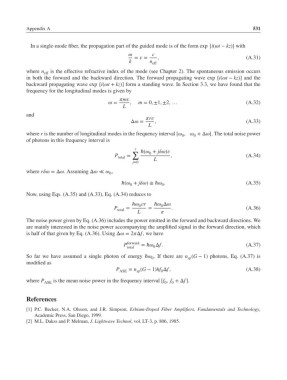Page 550 - Fiber Optic Communications Fund
P. 550
Appendix A 531
In a single-mode fiber, the propagation part of the guided mode is of the form exp [i(t − kz)] with
c
= = , (A.31)
k n
eff
where n eff is the effective refractive index of the mode (see Chapter 2). The spontaneous emission occurs
in both the forward and the backward direction. The forward propagating wave exp [i(t − kz)] and the
backward propagating wave exp [i(t + kz)] form a standing wave. In Section 3.3, we have found that the
frequency for the longitudinal modes is given by
m
= , m = 0, ±1, ±2, … (A.32)
L
and
r
Δ = , (A.33)
L
where r is the number of longitudinal modes in the frequency interval [ , +Δ]. The total noise power
0 0
of photons in this frequency interval is
r
∑ ℏ( + j)
0
P = , (A.34)
total L
j=0
where r =Δ. Assuming Δ≪ ,
0
ℏ( + j)≅ ℏ . (A.35)
0 0
Now, using Eqs. (A.35) and (A.33), Eq. (A.34) reduces to
ℏ r ℏ Δ
0
0
P total = = . (A.36)
L
The noise power given by Eq. (A.36) includes the power emitted in the forward and backward directions. We
are mainly interested in the noise power accompanying the amplified signal in the forward direction, which
is half of that given by Eq. (A.36). Using Δ = 2Δf,wehave
P forward = ℏ Δf. (A.37)
total 0
So far we have assumed a single photon of energy ℏ . If there are n (G − 1) photons, Eq. (A.37) is
0 sp
modified as
P ASE = n (G − 1)hf Δf, (A.38)
0
sp
where P ASE is the mean noise power in the frequency interval [f , f +Δf].
0
0
References
[1] P.C. Becker, N.A. Olsson, and J.R. Simpson, Erbium-Doped Fiber Amplifiers, Fundamentals and Technology,
Academic Press, San Diego, 1999.
[2] M.L. Dakss and P. Melman, J. Lightwave Technol, vol. LT-3, p. 806, 1985.

